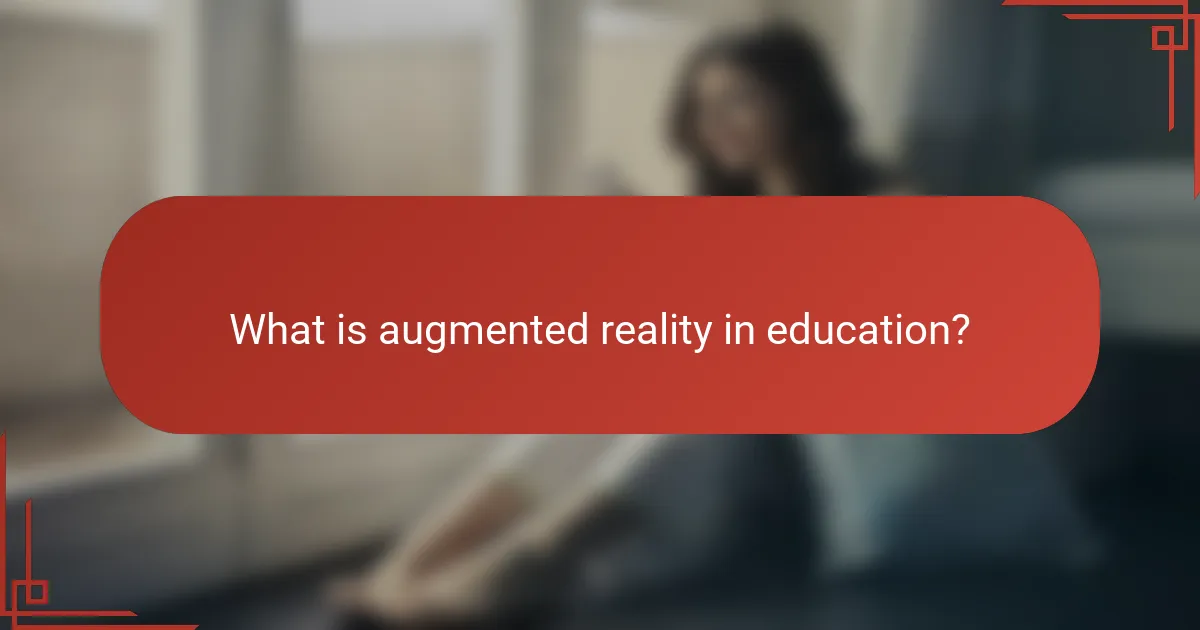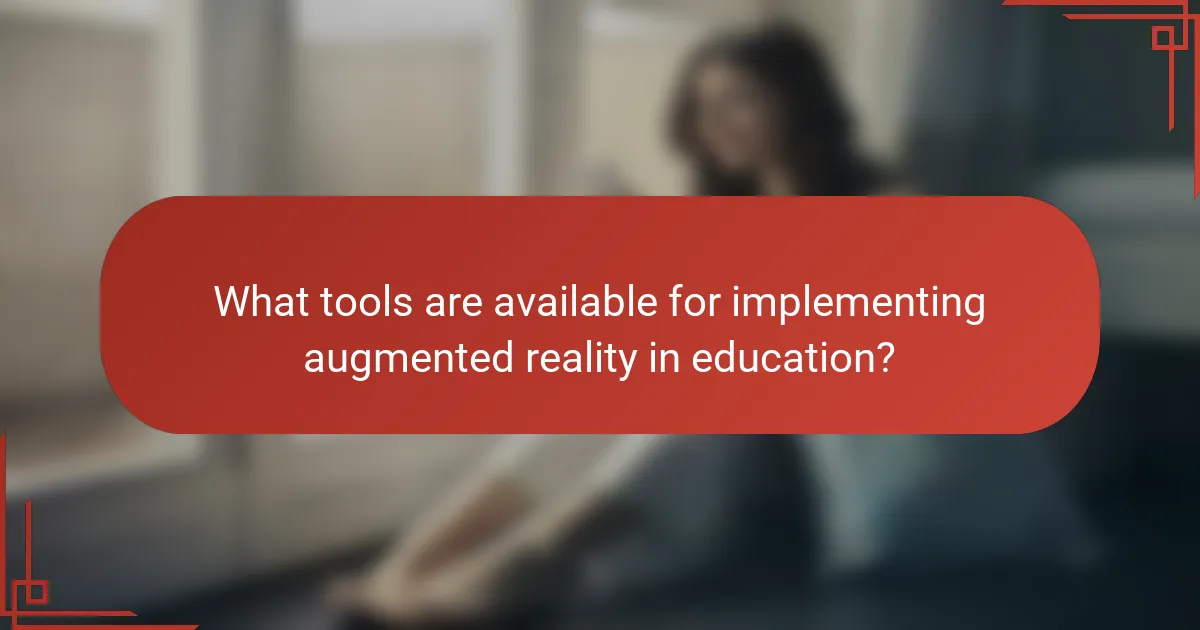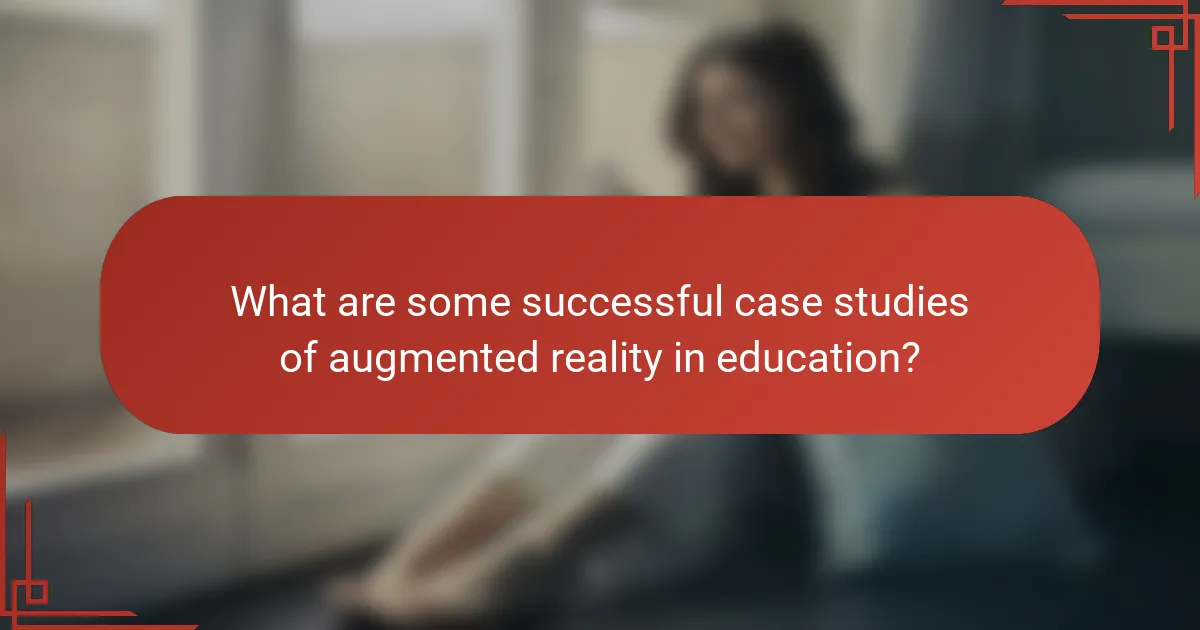Augmented reality (AR) in education is a technology that integrates digital information with the real world, enhancing learning through interactive and immersive experiences. This article explores the benefits of AR, including improved retention rates and understanding of complex subjects, supported by research findings such as those from Wu et al. (2013). It highlights various tools for implementing AR in educational settings, such as Google Expeditions, Merge Cube, and AR Flashcards, which facilitate engaging learning environments. Additionally, successful case studies demonstrate AR’s effectiveness in fields like medical training, history, and language learning, showcasing its potential to transform educational practices and outcomes.

What is augmented reality in education?
Augmented reality in education is a technology that overlays digital information onto the real world. It enhances the learning experience by providing interactive and immersive content. This technology allows students to visualize complex concepts in a more engaging manner. For example, AR can bring historical events to life or allow students to explore the human anatomy in 3D. Research indicates that augmented reality can improve retention rates and understanding. A study by Wu et al. (2013) found that students using AR achieved higher test scores compared to traditional learning methods. Thus, augmented reality serves as a powerful tool in modern educational practices.
How does augmented reality enhance the learning experience?
Augmented reality enhances the learning experience by providing interactive and immersive educational content. It allows students to visualize complex concepts in a tangible way. For example, AR can bring 3D models of the human body into a classroom. This visual representation aids in understanding anatomy better than traditional methods. Studies show that students using AR demonstrate improved retention of information. Research from the University of Maryland found that students using AR technology scored 40% higher on tests. Additionally, AR fosters engagement and motivation among learners. It transforms passive learning into an active exploration process. Overall, augmented reality significantly enriches educational experiences through enhanced interaction and understanding.
What are the key features of augmented reality in educational settings?
Key features of augmented reality in educational settings include immersive learning experiences, interactive content, and real-time feedback. Immersive learning allows students to engage with 3D models and simulations. This enhances understanding of complex subjects like science and mathematics. Interactive content encourages active participation and collaboration among students. Real-time feedback helps educators assess student progress instantly. Research shows that AR can improve retention rates by up to 70%. These features create a dynamic learning environment that fosters engagement and motivation.
How does augmented reality differ from traditional teaching methods?
Augmented reality (AR) enhances learning by integrating digital information with the real world. Traditional teaching methods often rely on textbooks and lectures, limiting interaction. AR offers immersive experiences that engage students actively. For example, AR can visualize complex concepts, such as anatomy or physics, in 3D. This visual representation aids comprehension and retention. Studies show that AR can improve learning outcomes significantly. A research study by Dunleavy and Dede (2014) found that students using AR demonstrated higher engagement and understanding compared to traditional methods. Thus, AR provides a dynamic alternative to conventional teaching.
What are the benefits of using augmented reality in education?
Augmented reality (AR) enhances education by providing immersive learning experiences. It allows students to interact with 3D models of complex subjects. This interaction improves engagement and retention of information. AR can visualize abstract concepts, making them easier to understand. For instance, anatomy students can explore the human body in detail. Studies show that AR can increase motivation and participation in lessons. Research by Wu et al. (2013) indicates that AR can lead to higher academic performance. Additionally, AR fosters collaboration among students, enhancing teamwork skills. Overall, AR transforms traditional learning into an interactive experience.
How does augmented reality improve student engagement?
Augmented reality enhances student engagement by providing interactive and immersive learning experiences. It allows students to visualize complex concepts in a tangible way. For example, AR can transform a static textbook into a dynamic 3D model. This interactivity captures students’ attention more effectively than traditional methods. Studies show that students using AR technology report higher levels of interest and motivation. According to a study published in the Journal of Educational Technology & Society, students engaged with AR tools demonstrated improved retention of information. This indicates that augmented reality not only engages students but also enhances their learning outcomes.
What impact does augmented reality have on knowledge retention?
Augmented reality significantly enhances knowledge retention. It engages multiple senses, which helps reinforce learning experiences. Studies indicate that learners using augmented reality retain information better than traditional methods. For instance, a study by Wu et al. (2013) found that AR can improve retention rates by up to 70%. This increase is attributed to interactive and immersive experiences that AR provides. When students actively participate, they are more likely to remember the material. Additionally, augmented reality facilitates visual learning, which is effective for complex subjects. Overall, augmented reality serves as a powerful tool for improving educational outcomes.
How can augmented reality support diverse learning styles?
Augmented reality (AR) supports diverse learning styles by providing interactive and immersive experiences. Visual learners benefit from AR’s ability to overlay graphics and animations onto real-world objects. Kinesthetic learners engage with content through hands-on activities facilitated by AR applications. Auditory learners can access narrated content and sound effects that enhance understanding. Studies show that AR increases student motivation and engagement, leading to improved retention rates. For instance, a study by Wu et al. (2013) found that AR enhances learning outcomes across various subjects. This adaptability makes AR a valuable tool in catering to multiple learning preferences.

What tools are available for implementing augmented reality in education?
Tools available for implementing augmented reality in education include Google Expeditions, Merge Cube, and AR Flashcards. Google Expeditions allows teachers to create immersive field trips using AR technology. Merge Cube enables students to hold and interact with 3D objects in their hands, enhancing learning experiences. AR Flashcards use augmented reality to bring traditional flashcards to life, making learning engaging. Other notable tools are Zspace, which offers a virtual reality experience, and Aurasma, which allows users to create their own AR content. These tools enhance student engagement and understanding of complex subjects through interactive learning.
What are the most popular augmented reality applications for education?
The most popular augmented reality applications for education include Google Expeditions, Merge Cube, and Quiver. Google Expeditions allows students to explore virtual field trips and 3D models. Merge Cube enables interactive learning experiences through hands-on activities. Quiver transforms coloring pages into animated 3D models, enhancing creativity. These applications are widely used in classrooms to engage students. They provide immersive experiences that improve understanding of complex subjects. Research indicates that AR applications can boost student motivation and retention rates.
How do these applications vary in functionality?
Augmented reality applications in education vary in functionality based on their specific use cases. Some applications focus on interactive learning experiences, allowing students to visualize complex concepts. Others provide immersive simulations that enhance practical skills in fields like medicine or engineering. Certain applications offer gamified learning, making educational content more engaging through competitive elements. Additionally, some tools enable collaborative learning, allowing multiple users to interact in a shared augmented space. The variation in functionality often aligns with the educational objectives they aim to achieve, such as enhancing understanding, improving retention, or fostering teamwork.
What are the costs associated with these tools?
Costs associated with augmented reality tools in education vary widely. Basic AR applications can range from free to several hundred dollars. Advanced AR platforms may require subscriptions or licenses costing thousands annually. Hardware costs, like AR glasses or tablets, can add hundreds to thousands of dollars. Implementation and training expenses may also arise, potentially increasing overall costs. Educational institutions often budget for these tools based on their specific needs and available funding.
How can educators effectively integrate augmented reality into their curriculum?
Educators can effectively integrate augmented reality (AR) into their curriculum by incorporating AR applications that enhance learning experiences. They should identify specific learning objectives that AR can support. For instance, AR can visualize complex concepts in subjects like science and mathematics.
Teachers can use AR tools such as Google Expeditions or Merge Cube to create interactive lessons. These tools allow students to explore 3D models and simulations, making learning more engaging. Additionally, educators should provide training for themselves and their students to maximize the use of AR technology.
A study by Huang et al. (2019) found that AR applications significantly improved student engagement and understanding in various subjects. This evidence supports the effectiveness of AR in educational settings.
What are the best practices for using augmented reality in lesson planning?
Best practices for using augmented reality in lesson planning include aligning AR content with learning objectives. This ensures that the technology enhances educational goals. Teachers should select AR tools that are user-friendly and accessible. This facilitates smoother integration into the classroom. Additionally, incorporating hands-on activities can enhance student engagement. Research shows that interactive experiences improve retention rates. Collaborative projects using AR promote teamwork and communication skills. Educators should also provide clear instructions for students. This helps in minimizing confusion during AR activities. Finally, assessing the effectiveness of AR lessons is crucial. Feedback can guide future lesson improvements.
How can teachers assess the effectiveness of augmented reality in their classrooms?
Teachers can assess the effectiveness of augmented reality in their classrooms through various methods. They can use student performance metrics to evaluate learning outcomes. Comparing test scores before and after AR implementation provides measurable data. Surveys and feedback from students can offer insights into engagement and understanding. Observations during AR activities can help assess student interaction and participation levels. Additionally, analyzing retention rates of information learned through AR can indicate effectiveness. Research by Wu et al. (2013) shows that AR can enhance learning experiences and outcomes. Thus, these assessment methods provide a comprehensive view of AR’s impact in educational settings.

What are some successful case studies of augmented reality in education?
Successful case studies of augmented reality in education include the use of AR in medical training, history lessons, and language learning. In medical training, the University of California, Davis, implemented AR to allow students to visualize anatomy in 3D. This enhanced understanding of complex structures and improved retention rates. In history lessons, the app “Civilisations AR” brought historical artifacts to life for students, resulting in increased engagement and interest. Language learning apps like “Mondly” utilize AR to create immersive experiences, helping learners practice in real-world scenarios. These case studies demonstrate the effectiveness of AR in enhancing educational outcomes and student engagement.
What institutions have successfully implemented augmented reality in their programs?
Stanford University has successfully implemented augmented reality in its programs. The university utilizes AR for enhancing medical training. The Virtual Reality Medical Center at Stanford provides immersive simulations for students. Another example is the University of Maryland. It employs AR in engineering courses to visualize complex concepts. The University of Illinois also integrates AR into its curriculum. It enhances learning in architecture and design programs. Additionally, the University of Southern California uses AR in its film school. This allows students to create interactive narratives. These institutions showcase the effective use of augmented reality in educational settings.
What specific outcomes were achieved in these case studies?
Specific outcomes achieved in the case studies include improved student engagement and understanding. Students demonstrated higher retention rates of information when using augmented reality tools. Enhanced collaboration among students was also noted, fostering teamwork in learning environments. Additionally, teachers reported increased motivation and enthusiasm in their classrooms. The integration of augmented reality led to a more interactive learning experience, making complex subjects more accessible. Quantitative data showed a significant rise in test scores post-implementation of AR technology. These outcomes collectively highlight the positive impact of augmented reality in educational settings.
What lessons can be learned from these implementations?
Implementations of augmented reality (AR) in education reveal several key lessons. First, AR enhances student engagement through interactive experiences. Studies show that students using AR tools demonstrate higher motivation levels. Second, AR supports diverse learning styles, catering to visual, auditory, and kinesthetic learners. Research indicates that personalized learning experiences improve knowledge retention. Third, teacher training is crucial for effective AR integration. Proper training ensures educators can utilize AR tools effectively. Fourth, collaboration between educators and technology developers fosters better AR resources. Successful case studies highlight the importance of tailored content for specific educational needs. Lastly, ongoing assessment of AR’s impact on learning outcomes is essential. Data-driven evaluations help refine AR applications in educational settings.
How can educators overcome challenges when using augmented reality in education?
Educators can overcome challenges when using augmented reality (AR) in education by providing adequate training and resources. Effective professional development helps teachers understand AR tools and their applications. Collaborating with technology experts can enhance teachers’ confidence in using AR. Additionally, integrating AR into existing curricula can make implementation smoother. Addressing technical issues proactively ensures a seamless user experience. Offering support for diverse learning styles makes AR accessible to all students. Research indicates that schools with dedicated AR training report higher student engagement and learning outcomes. By adopting these strategies, educators can effectively leverage AR in their teaching practices.
What common obstacles do educators face with augmented reality adoption?
Common obstacles educators face with augmented reality adoption include high costs, lack of training, and limited resources. High costs can deter schools from investing in AR technology. Many educators feel unprepared to integrate AR into their teaching methods due to insufficient training. Limited resources, such as outdated hardware or software, can hinder effective implementation. Additionally, some educators may encounter resistance from administration or colleagues who are skeptical about the benefits of AR. These challenges can impede the successful adoption of augmented reality in educational settings.
What strategies can be employed to address these challenges?
To address challenges in implementing augmented reality in education, several strategies can be employed. First, training educators on AR technology is crucial. Research shows that well-trained teachers are more effective in integrating new tools. Second, developing user-friendly AR applications is essential. Simplified interfaces enhance student engagement and learning outcomes. Third, ensuring adequate technological infrastructure is necessary. Schools must invest in devices and reliable internet access. Fourth, fostering collaboration between educators and developers can lead to tailored solutions. This partnership can address specific educational needs. Lastly, gathering feedback from students and teachers helps refine AR experiences. Continuous improvement based on user input leads to better educational outcomes.
What are the future trends of augmented reality in education?
Future trends of augmented reality in education include personalized learning experiences and enhanced engagement. Augmented reality will allow students to interact with 3D models and simulations. This interaction can lead to improved understanding of complex subjects. Another trend is the integration of augmented reality with artificial intelligence. This combination can provide adaptive learning pathways tailored to individual student needs. Additionally, augmented reality will facilitate remote learning environments. Students can access immersive educational experiences from anywhere. Research indicates that immersive technologies can increase retention rates by up to 75%. Furthermore, collaborative learning through augmented reality will become more prevalent. Students will work together on projects in virtual environments, fostering teamwork and communication skills.
How is technology evolving to support augmented reality in learning?
Technology is evolving to support augmented reality in learning through advancements in hardware and software. Enhanced mobile devices now feature powerful processors and high-resolution displays. This allows for more immersive experiences in educational applications. Additionally, cloud computing enables real-time data processing and storage, facilitating complex AR interactions. Software development kits (SDKs) are becoming more accessible, allowing educators to create custom AR content easily. Machine learning algorithms are improving object recognition and tracking, enhancing the user experience. Furthermore, platforms like Google ARCore and Apple ARKit are providing robust frameworks for developers. Research indicates that AR can improve engagement and retention in learning environments. Studies show that students using AR technologies perform better in understanding complex concepts.
What predictions can be made about the role of augmented reality in future educational practices?
Augmented reality (AR) will significantly enhance future educational practices. Predictions indicate AR will facilitate immersive learning experiences. Students will engage with content in interactive ways. This technology will enable real-time visualization of complex concepts. For example, anatomy students can explore 3D models of the human body. Research shows that AR can improve retention rates by up to 70%. Educators will utilize AR to create customized learning environments. This adaptability will cater to diverse learning styles. Overall, AR is poised to transform traditional teaching methods into dynamic learning experiences.
What practical tips can educators follow for successful augmented reality implementation?
Educators can successfully implement augmented reality (AR) by following several practical tips. First, they should select AR applications that align with their curriculum. This ensures that the technology enhances learning objectives. Second, educators must provide adequate training for both teachers and students. Familiarity with AR tools increases confidence and effectiveness in usage. Third, they should start with small, manageable projects. This allows for gradual integration and reduces overwhelm. Fourth, educators need to encourage collaboration among students. AR can facilitate teamwork and enhance engagement through shared experiences. Fifth, they should gather feedback from students. Understanding user experience can guide future implementations. Lastly, educators must evaluate the impact of AR on learning outcomes. This assessment can inform adjustments and improvements in future use. These strategies are supported by case studies showing improved student engagement and learning retention through AR applications in educational settings.
Augmented reality (AR) in education is a transformative technology that overlays digital information onto the real world, enhancing learning experiences through interactive and immersive content. This article explores the benefits of AR, including improved student engagement, retention rates, and understanding of complex subjects. It also examines various tools and applications available for implementing AR in educational settings, alongside successful case studies from institutions that have effectively integrated AR into their programs. Additionally, the article addresses challenges educators face with AR adoption and offers practical strategies for successful implementation in the classroom.


